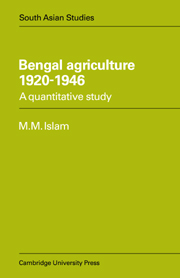Book contents
- Frontmatter
- Contents
- List of tables
- List of figures
- Foreword
- Preface
- Introduction
- PART ONE
- 1 Nature of crop statistics and revision
- 2 Trends in output, acreage and yield: all-crops, food crops and cash crops
- 3 Trends in output, acreage and yield: individual crops
- PART TWO
- Conclusion
- Appendix: statistical tables
- Select bibliography
- Index
3 - Trends in output, acreage and yield: individual crops
from PART ONE
Published online by Cambridge University Press: 15 December 2009
- Frontmatter
- Contents
- List of tables
- List of figures
- Foreword
- Preface
- Introduction
- PART ONE
- 1 Nature of crop statistics and revision
- 2 Trends in output, acreage and yield: all-crops, food crops and cash crops
- 3 Trends in output, acreage and yield: individual crops
- PART TWO
- Conclusion
- Appendix: statistical tables
- Select bibliography
- Index
Summary
Percentage rates of change presented in the preceding chapter reveal the picture of a stagnant agricultural economy characterised by the near-constancy of both acreage under cultivation and yield at the aggregate level. In the present chapter the analysis is taken a step further by examining whether this picture was representative of all the individual crops. There are several questions that need resolving. For example, if the trends were dissimilar, what was the significance of this difference? Again, it is imperative to seek some possible explanations for these dissimilarities. The mode of presentation is more or less the same as in the previous chapter. In the discussion on the quinquennial trends the emphasis is on the provincial average. In order to facilitate the interpretation of the rates of change in the 13 crops selected for analysis their weights in the all-crops acreage and allcrop output at the all-Bengal level are shown in the respective tables. The analysis of the changes is followed by an attempt to explain the differences in regional trends.
PROVINCIAL AND REGIONAL RATES OF CHANGE IN THE CROP OUTPUT
Considerable variations are noticed in the trends of the output of individual crops (Table 3.1). In both series the annual rates of growth were highest for sugarcane and gram. In the case of the former this has to be attributed to the introduction of a protective tariff against the import of sugar and the consequent expansion of local manufacture. The remarkable expansion in the output of gram started in the middle of the 1930s despite the fact that exports of this crop had been declining since the beginning of the period under review.
- Type
- Chapter
- Information
- Bengal Agriculture 1920–1946A Quantitative Study, pp. 84 - 106Publisher: Cambridge University PressPrint publication year: 1979

